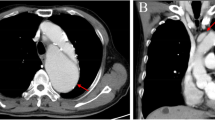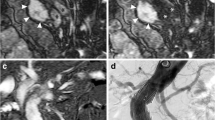Abstract
Our aim was to investigate the possibility of ruling out endoleak after endovascular aortic repair (EVAR) of abdominal aortic aneurysm (AAA) using non-contrast MRI. Twenty-three patients (20 males, aged 73 ± 8 years) with an EVAR-treated AAA underwent 1.5-T MRI using axial, coronal and sagittal oblique true-FISP sequences. Two blinded and independent readers with 4 (R1) and 2 (R2) years of experience evaluated these images considering an area of even less than 5 mm in diameter with a signal intensity higher than that of normal muscles visible in the excluded aneurysmal sac as a sign of potential endoleak. The final assessment, mainly based on MR angiography and previous examinations, served as reference standard. Out of 23 patients, 13 (57 %) were negative for endoleak at final assessment, while the remaining 10 (43 %) were positive, with the following type distribution: Ia (n = 4), Ib (n = 2), II (n = 3), and III (n = 1). Sensitivity was 10/10 (100 %; CI 95 % 69–100 %), specificity 7/13 (54 %; 25–81 %), accuracy 17/23 (74 %; 52–90 %), PPV 10/16 (63 %; 35–85 %) and NPV 7/7 (100 %; 59–100 %) for R1; 9/10 (90 %; 56–100 %), 8/13 (62 %; 32–86 %), 17/23 (74 %; 52–90 %), 9/14 (64 %; 35–87 %), and 8/9 (89 %; 52–100 %) for R2, respectively. Inter-reader Cohen κ was 0.810. A negative non-contrast true-FISP MR study can be used to rule out endoleak after EVAR of AAA. This hypothesis may contribute to the reduction of ionizing radiation exposure and contrast material administration for monitoring patients with an EVAR-treated AAA.



Similar content being viewed by others
References
Parodi JC, Palmaz JC, Barone HD (1991) Transfemoral intraluminal graft implantation for abdominal aortic aneurysms. Ann Vasc Surg 5:491–499
Zarins CK, White RA, Fogarty TJ (2000) Aneurysm rupture after endovascular repair using the AneuRx stent graft. J Vasc Surg 31:960–970
Stavropoulos SW, Charagundla SR (2007) Imaging techniques for detection and management of endoleaks after endovascular aortic aneurysm repair. Radiology 243:641–655
White GH, Yu W, May J, Chaufour X, Stephen MS (1997) Endoleak as a complication of endoluminal grafting of abdominal aortic aneurysms: classification, incidence, diagnosis, and management. J Endovasc Surg 4:152–168
Faries PL, Cadot H, Agarwal G, Kent KC, Hollier LH, Marin ML (2003) Management of endoleak after endovascular aneurysm repair: cuffs, coils, and conversion. J Vasc Surg 37:1155–1161
Chernyak V, Rozenblit AM, Patlas M et al (2006) Type II endoleak after endoaortic graft implantation: diagnosis with helical CT arteriography. Radiology 240:885–893
Mita T, Arita T, Matsunaga N et al (2000) Complications of endovascular repair for thoracic and abdominal aortic aneurysm: an imaging spectrum. Radiographics 20:1263–1278
Rozenblit AM, Patlas M, Rosenbaum AT et al (2003) Detection of endoleaks after endovascular repair of abdominal aortic aneurysm: value of unenhanced and delayed helical CT acquisitions. Radiology 227:426–433
Iezzi R, Cotroneo AR, Marano R, Filippone A, Storto ML (2008) Endovascular treatment of thoracic aortic diseases: follow-up and complications with multi-detector computed tomography angiography. Eur J Radiol 65:365–376
Corriere MA, Feurer ID, Becker SY et al (2004) Endoleak following endovascular abdominal aortic aneurysm repair: implications for duration of screening. Ann Surg 239:800–805
Lookstein RA, Goldman J, Pukin L, Marin ML (2004) Time-resolved magnetic resonance angiography as a noninvasive method to characterize endoleaks: initial results compared with conventional angiography. J Vasc Surg 39:27–33
Cohen EI, Weinreb DB, Siegelbaum RH et al (2008) Time-resolved MR angiography for the classification of endoleaks after endovascular aneurysm repair. J Magn Reson Imaging 27:500–503
Iozzelli A, D’Orta G, Aliprandi A, Secchi F, Di Leo G, Sardanelli F (2009) The value of true-FISP sequence added to conventional gadolinium-enhanced MRA of abdominal aorta and its major branches. Eur J Radiol 72:489–493
Harris PL, Vallabhaneni SR, Desgranges P, Becquemin JP, van Marrewijk C, Laheij RJ (2000) Incidence and risk factors of late rupture, conversion, and death after endovascular repair of infrarenal aortic aneurysms: the EUROSTAR experience. European collaborators on stent/graft techniques for aortic aneurysm repair. J Vasc Surg 32:739–749
Eskandari MK, Yao JS, Pearce WH et al (2001) Surveillance after endoluminal repair of abdominal aortic aneurysms. Cardiovasc Surg 9:469–471
Baum RA, Stavropoulos SW, Fairman RM, Carpenter JP (2003) Endoleaks after endovascular repair of abdominal aortic aneurysms. J Vasc Interv Radiol 14:1111–1117
Trimboli RM, Mauri G, Tosi G, Brambilla G, Di Leo G, Cornalba G, Sardanelli F (2011) Follow-up with CT imaging after endovascular abdominal aneurysm repair: how much is the dose? Book of Abstracts, ECR 2011 (SS 115), B-047
Martin DR, Semelka RC et al (2009) Nephrogenic systemic fibrosis versus contrast-induced nephropathy: risks and benefits of contrast-enhanced MR and CT in renally impaired patients. J Magn Reson Imaging 30:1350–1356
Conflict of interest
F. Sardanelli has received research grants from and is a member of speakers’ bureau for Bracco Group. No conflicts of interest have to be declared by any of the other authors.
Author information
Authors and Affiliations
Corresponding author
Rights and permissions
About this article
Cite this article
Resta, E.C., Secchi, F., Giardino, A. et al. Non-contrast MR imaging for detecting endoleak after abdominal endovascular aortic repair. Int J Cardiovasc Imaging 29, 229–235 (2013). https://doi.org/10.1007/s10554-012-0060-2
Received:
Accepted:
Published:
Issue Date:
DOI: https://doi.org/10.1007/s10554-012-0060-2




